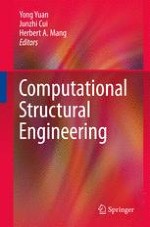Following the great progress made in computing technology, both in computer and programming technology, computation has become one of the most powerful tools for researchers and practicing engineers. It has led to tremendous achievements in computer-based structural engineering and there is evidence that current devel- ments will even accelerate in the near future. To acknowledge this trend, Tongji University, Vienna University of Technology, and Chinese Academy of Engine- ing, co-organized the International Symposium on Computational Structural En- neering 2009 in Shanghai (CSE’09). CSE’09 aimed at providing a forum for presentation and discussion of sta- of-the-art development in scientific computing applied to engineering sciences. Emphasis was given to basic methodologies, scientific development and engine- ing applications. Therefore, it became a central academic activity of the Inter- tional Association for Computational Mechanics (IACM), the European Com- nity on Computational Methods in Applied Sciences (ECCOMAS), The Chinese Society of Theoretical and Applied Mechanic, the China Civil Engineering So- ety, and the Architectural Society of China. A total of 10 invited papers, and around 140 contributed papers were p- sented in the proceedings of the symposium. Contributors of papers came from 20 countries around the world and covered a wide spectrum related to the compu- tional structural engineering.
